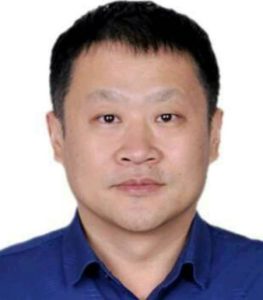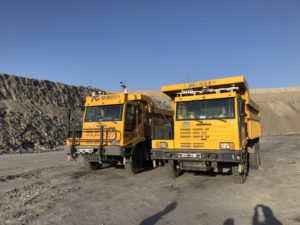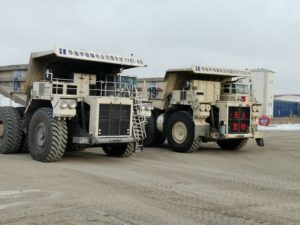In a world first, Paul Moore spoke to the senior management of TAGE Idriver, in Beijing, the leading Chinese player in mining truck autonomy solutions, both for new machines and retrofits. CEO Professor Yu Guizhen, CTO Huang Liming and Head of Marketing Li Qingshe gave their insight on this huge and rapidly growing market.
PM: Can you give some background on TAGE Idriver as a robotics solution company and how you came to be active in the mining sector?

YG: Founded in 2016, Beijing TAGE Idriver Technology Co Ltd (hereafter referred to as TAGE) is a high-tech enterprise focussed on the research and development of autonomous driving technology for open-pit mining vehicles. Open-pit mining is regarded as one of the most ideal applications for autonomous driving technology implementation as it involves a relatively restricted area where vehicle speed is low and the transportation routes are well managed. As such, we took the unmanned robotic mining truck as our chosen breakthrough point, to try to help to solve the long standing issues with open-pit mining haulage such as frequent accidents, driver recruitment difficulty and persistently high cost. And we have achieved a lot so far – our system has already been successfully implemented in the Bayan Obo iron ore and rare earths mine (Baogang Group) and the Huolinhe coal mines (SPIC) in Inner Mongolia.
PM: It seems only recently the major mining equipment OEMs in China were working on their own autonomy solutions, but now independent players are dominating…what has changed?
YG: Unmanned transportation solutions for open-pit mines involve complex systems requiring not only vehicle technology, but also autonomous driving technology, dispatching and fleet management technology, and vehicle communication technology. To independently build all those capabilities into one platform is a tough challenge for the Chinese traditional mining equipment OEMs. This is why independent players with advanced autonomous driving technology but working in close cooperation with the OEMs are in a more competitive position to deliver open-pit mine unmanned transportation solutions in China.
PM: The market for these independent autonomy system tech providers seems very competitive in China; several other companies are also active – what would you say makes TAGE Idriver stand out from the rest?
HL: First I would say system integrity. As the earliest player engaged in the development of unmanned transportation solutions for open-pit mining and the first to put them into practical operation in China, TAGE has delivered complete solutions and has a mature product portfolio including OBU (Onboard Unit) product series, RSU (Road Side Unit) and Cloud Control Platform. The OBU product series includes unmanned mine truck terminal products, bulldozer vehicle terminal products, excavator vehicle terminal products, crushing station terminal products and external on-road vehicles terminal products. Then there is functional adaptability. Open-pit mine transportation is complex, especially in China. On the basis of intellectualisation and interconnection of the unmanned mine trucks and the cloud based dispatching control platform, TAGE’s products seamlessly connect every step of mining transportation process, so as to make the system capable of working in an actual operational scenario, which is extremely critical for commercial implementation.

Then there is system reliability and multiple safety aspects. TAGE’s OBU products are designed in accordance with vehicle grade certification to meet the operational reliability requirements of the harsh environments (low temperature, vibration, etc) in the mining area. Our system has achieved multiple redundant security designs, which mainly includes CCU (Central Control Unit) security redundancy, wireless network redundancy, cloud platform DHBS (Dual Machine Hot Backup System) redundancy, etc. Finally I would mention engineering design ability. TAGE has a vertically structured and expert team in the open-pit mining industry, who have rich experience in engineering design and system simulation verification of unmanned transportation in mining.
PM: Is the main potential currently working with equipment OEMs or the mines directly, or both?
YG: Both, I have mentioned already Baogang and SPIC as mining customers we have ongoing projects with and we are also closely cooperating with top Chinese OEMs like Inner Mongolia North Hauler (NHL), XCMG and Shaanxi Tonly.
PM: The Chinese market is also very price sensitive. How is it possible to provide these complex technologies to these mines at a low enough price they will accept?

LQ: In China, the ordinary consumer market is very price sensitive, but for high-tech production equipment, price is not the decisive factor. TAGE’s unmanned system is capable of creating substantial additional benefits to customers such as labour cost savings, increased operation time, reduced fuel cost and tyre wear cost reduction, and most importantly, zero accident risk to operators. Meanwhile, our prices are still very competitive – the ROI of our system is very attractive to most of our potential customers.
PM: Chinese mines are not known for having extensive comms networks or using the latest fleet management systems. How do you ensure your mining customers meet the minimum standards your systems need to work in terms of networks?
HL: When it comes to telecommunication, China has a good upstream and downstream ecosystem, and wireless communication networks have been widely deployed in mining areas in China. Some large state-owned mining areas have already deployed 4G wireless private networks, so as to realise fleet management and video monitoring under manned transportation conditions. Along with the rapid introduction of unmanned transportation in China’s open-pit mining areas, 4G private networks or 5G networks have been mainly chosen as the mainstream choices for new mining area construction and existing mining area network upgrades. Currently, the major equipment manufacturers and communication service operators are actively cooperating with us to promote unmanned transportation and 5G.
PM: Are Chinese mines now widely trialling LTE and 5G networks? Do you think many mines will go straight to these latest technologies?
HL: As I said, telecommunication technology in China is developing rapidly. China’s Government has spared no efforts to promote the macro strategy of ‘New Infrastructure Construction’. In this positive environment, many mine areas have begun promoting 5G demonstration projects, and TAGE has also carried out 5G demonstration implementation at one of our unmanned transportation projects.
PM: Is there potential for autonomous mining in Chinese underground mines and is this something already happening? Is it a market TAGE Idriver is involved in yet?
YG: China has a large number of underground mines but in many of them mechanised hauling with mobile vehicles is not the major means of transportation – many of these mines instead use conveyors, skip haulage, etc. But we are aware that a variety of autonomous transportation equipment types are being experimented with in Chinese underground mining, however, TAGE is currently focusing on the open-pit mining industry only.
PM: How would you say your system differs from those offered in the global market by Cat, Komatsu, Hitachi and ASI?

HL: To start with, TAGE’s system designs are based on China’s unique mining area circumstances and transportation process requirements, which are often more difficult and more complex than the mining situations in which overseas counterparts are working. In order to ensure continuity, efficiency, and reliability, we must consider in our offering allowing switching between various driving modes (such as from manned to unmanned or to remote control etc) so as to adapt to the unique characteristics of China’s mining areas. Secondly, the vehicle models utilised in China’s mining areas are quite diverse. There are many brands and types of rigid mine trucks but also many types of non-rigid wide-body dumpers, sometimes called tipper trucks, in China, so our OBUs have to adapt to the control characteristics of various truck models to serve the different customers. In the mining areas where wide-body dumpers are deployed, there are usually hundreds of them in the fleet and sometimes more than a thousand, which places harsh requirements in terms of capacity and reliability on the cloud-based dispatching and control system. Finally, there are a large number of existing mine trucks in China, so to offer autonomous modification solutions ie retrofits for those existing trucks has huge commercial potential. We have already accumulated rich engineering experience and made considerable commercial progress in this field.
PM: What is making big mining groups in China look at automation, is the major push a drive towards safety or productivity, or both?
YG: Both. Productivity is obviously important, but safety is probably the top concern as the Chinese Government has issued strict legal rules that impose stringent safety requirements on mine management.
PM: Most of the Chinese examples of autonomous fleets I have read about seem to be closed loop trials – are any Chinese mines actually using autonomous fleets in normal production yet?
LQ: The attempts at unmanned transportation of mining vehicles in China started much later than that in other countries. The whole industry is still in the transformation stage from small batch trial operations to large scale commercial implementation. As the leading player and the first to get commercial contracts in China, TAGE is standing at the forefront of the industry both in terms of technology maturity and user acceptance. We achieved multi-fleet unmanned operation in Bayan Obo iron mine in 2019, and by the end of 2020, all the mine trucks there will have been modified and fully put into unmanned transportation. For the non-rigid wide-body dumpers, we recently signed a large contract for 200 unmanned dumpers in the Ordos coal mining region. This project will be completed within two years, and the first batch of 50 dumpers will be in operation by the end of 2020. Some other contracts are also under negotiation, so we can say that the large scale commercial implementation phase is already underway.
PM: I have not seen reference to autonomy being applied at some of the largest operations like the Zhungeer, Pingshuo coal mines or the Julong Copper mine in Tibet, are these operations also looking at autonomy?
LQ: TAGE’s existing customers like Baogang and SPIC are giants in their respective fields. And the large mining groups Zhungeer, Pingshuo and Julong that you mentioned have also been paying close attention to unmanned transportation. We are communicating with them closely and they have clearly expressed their intention to carry out unmanned transportation projects going forward.
PM: The focus currently seems to be mining trucks. What about blasthole drill or excavator autonomy – is this an area you are also working on and can you give any examples?
HL: At present, in order to ensure the high efficiency of transportation, we have only developed and deployed unmanned systems on mine trucks. As for blasthole drill rigs, excavators, bulldozers and other auxiliary equipment, although they are still operator controlled, we have upgraded them with vehicle terminal devices to enable them to locate and interactively cooperate with unmanned mine truck fleets.
PM: On the truck side, is the focus mainly on larger trucks or are you also working on projects involving smaller trucks, eg 100 t class and smaller, including the tipper non-rigid trucks that are very common in Chinese mines?
HL: Our current solution is adaptable to both large mine trucks and non-rigid wide-body dumpers. The two types of truck are mainly different in terms of vehicle control. In addition, the transportation technical procedure is different in the mine areas using the two types of truck, so we have to do adaptive development to meet the specific needs of each fleet type.

PM: How significant is your recently signed deal with NHL to work with them to produce a new NTE200AT truck – is this the first time your system will have been applied to a ‘new’ mining truck as opposed to a retrofit?
YG: Yes and no, we started to modify NHL’s existing mine trucks with unmanned technology via retrofit in 2018, and have also jointly developed drive-by-wire trucks with a pre-installed unmanned system. This year we are confident we will carry out pre-installation with our proven solution on a large scale with the new NTE200AT 186 t truck fleet for SPIC, which will be a new milestone for us and for NHL.
PM: Do you see a lot of opportunities for TAGE Idriver outside of the China market such as where Chinese trucks are being sold (eg the new NHL deal with Yancoal), or where you are able to work with older or more basic truck designs, such as in India?
YG: We hope of course to work together with Chinese mine equipment OEMs to serve their customers both in China but also all over the world, as the use of Chinese mining trucks in the global market is increasing.
Fonte: IM – International Mining





